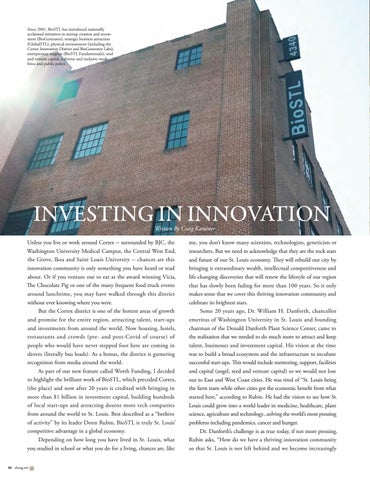Since 2001, BioSTL has introduced nationally acclaimed initiatives in startup creation and investment (BioGenerator), strategic business attraction (GlobalSTL), physical environment (including the Cortex Innovation District and BioGenerator Labs), entrepreneur support (BioSTL Fundamentals), seed and venture capital, a diverse and inclusive workforce and public policy.
INVESTING IN INNOVATION Written By Craig Kaminer
Unless you live or work around Cortex -- surrounded by BJC, the Washington University Medical Campus, the Central West End, the Grove, Ikea and Saint Louis University -- chances are this innovation community is only something you have heard or read about. Or if you venture out to eat at the award winning Vicia, The Chocolate Pig or one of the many frequent food truck events around lunchtime, you may have walked through this district without ever knowing where you were. But the Cortex district is one of the hottest areas of growth and promise for the entire region, attracting talent, start-ups and investments from around the world. Now housing, hotels, restaurants and crowds (pre- and post-Covid of course) of people who would have never stepped foot here are coming in droves (literally bus loads). As a bonus, the district is garnering recognition from media around the world. As part of our new feature called Worth Funding, I decided to highlight the brilliant work of BioSTL, which preceded Cortex, (the place) and now after 20 years is credited with bringing in more than $1 billion in investment capital, building hundreds of local start-ups and attracting dozens more tech companies from around the world to St. Louis. Best described as a “beehive of activity” by its leader Donn Rubin, BioSTL is truly St. Louis’ competitive advantage in a global economy. Depending on how long you have lived in St. Louis, what you studied in school or what you do for a living, chances are, like 66 slmag.net
me, you don’t know many scientists, technologists, geneticists or researchers. But we need to acknowledge that they are the rock stars and future of our St. Louis economy. They will rebuild our city by bringing it extraordinary wealth, intellectual competitiveness and life-changing discoveries that will renew the lifestyle of our region that has slowly been fading for more than 100 years. So it only makes sense that we cover this thriving innovation community and celebrate its brightest stars. Some 20 years ago, Dr. William H. Danforth, chancellor emeritus of Washington University in St. Louis and founding chairman of the Donald Danforth Plant Science Center, came to the realization that we needed to do much more to attract and keep talent, businesses and investment capital. His vision at the time was to build a broad ecosystem and the infrastructure to incubate successful start-ups. This would include mentoring, support, facilities and capital (angel, seed and venture capital) so we would not lose out to East and West Coast cities. He was tired of “St. Louis being the farm team while other cities got the economic benefit from what started here,” according to Rubin. He had the vision to see how St. Louis could grow into a world leader in medicine, healthcare, plant science, agriculture and technology...solving the world’s most pressing problems including pandemics, cancer and hunger. Dr. Danforth’s challenge is as true today, if not more pressing. Rubin asks, “How do we have a thriving innovation community so that St. Louis is not left behind and we become increasingly



